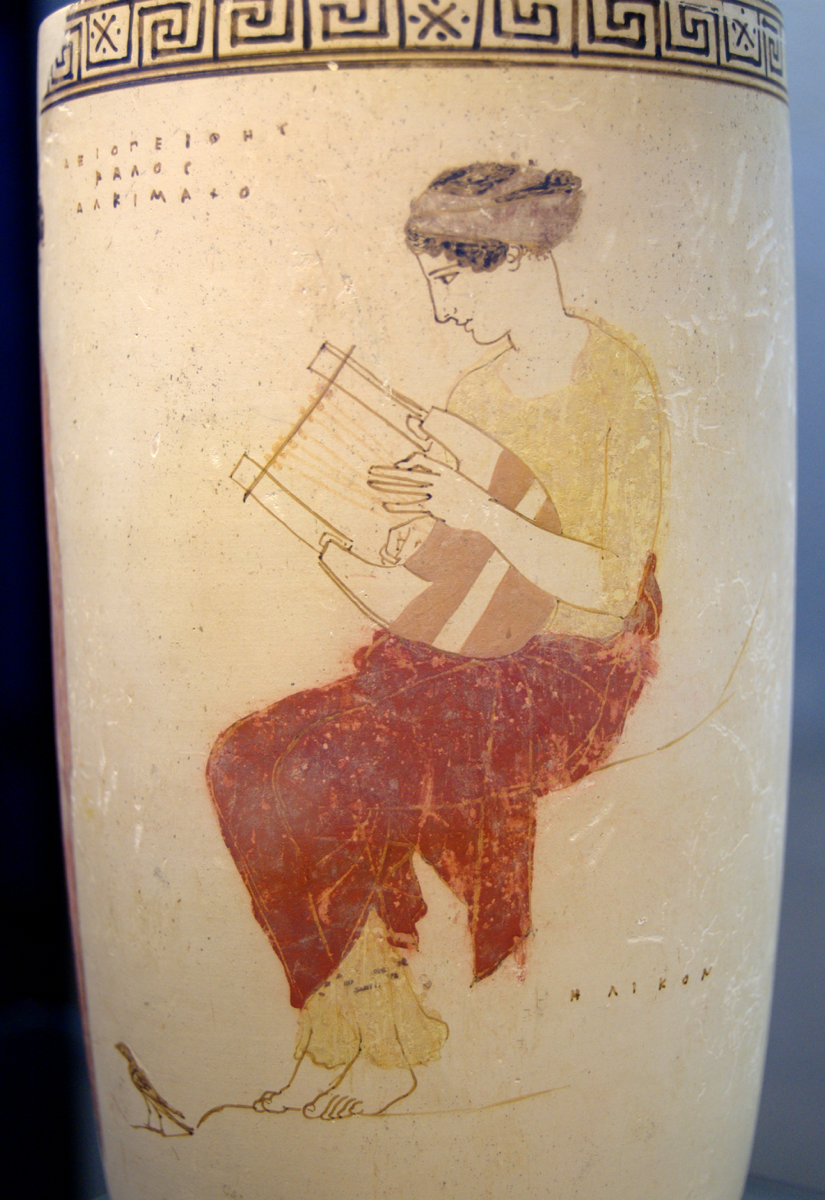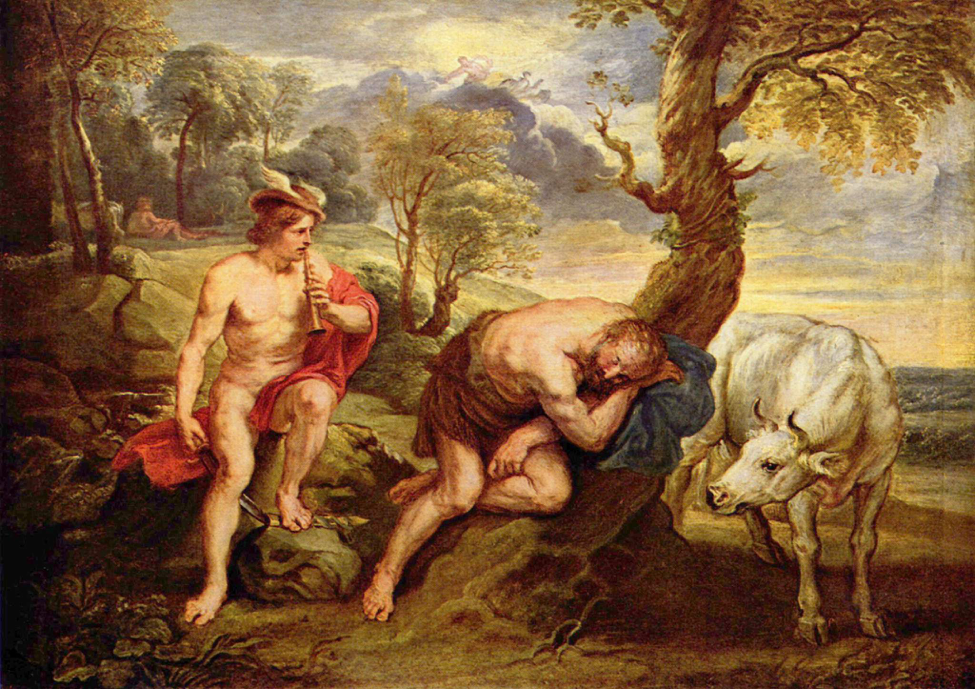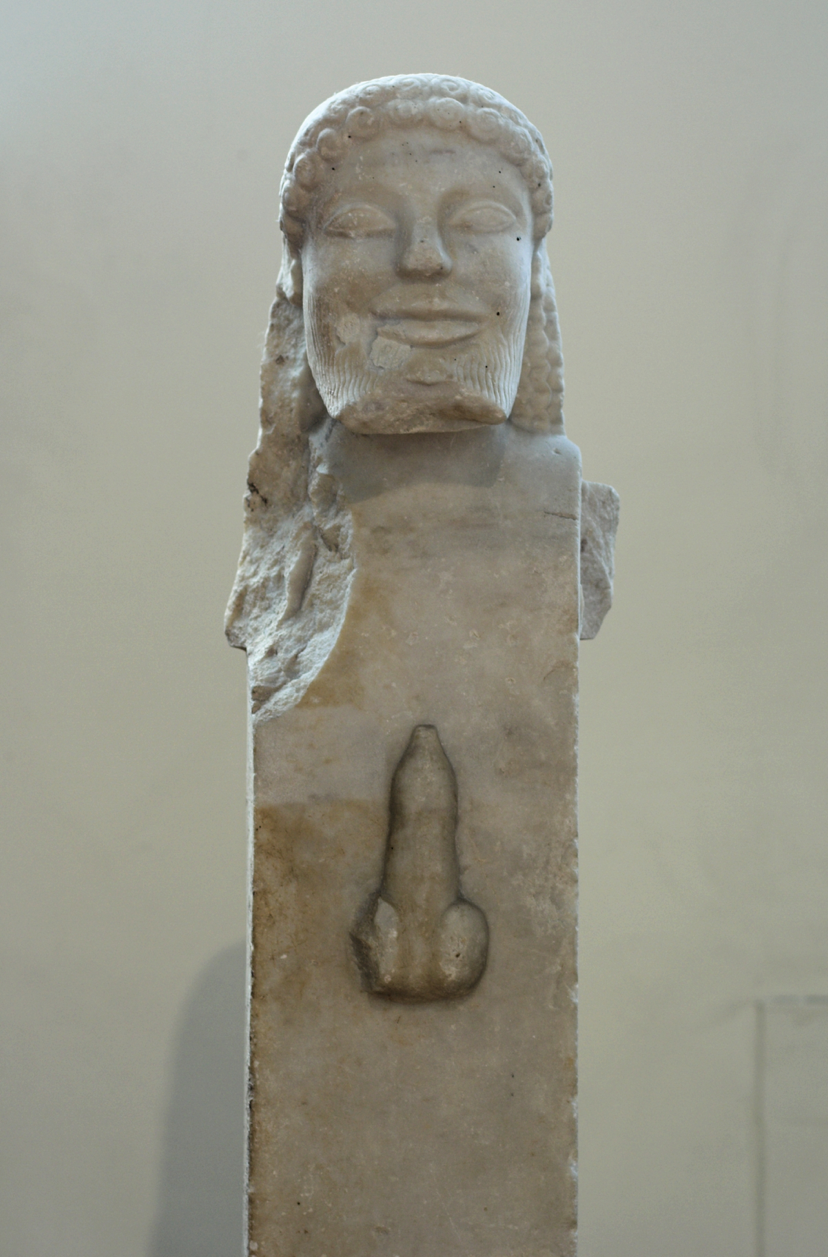1.17: Hermes
- Page ID
- 15354
\( \newcommand{\vecs}[1]{\overset { \scriptstyle \rightharpoonup} {\mathbf{#1}} } \)
\( \newcommand{\vecd}[1]{\overset{-\!-\!\rightharpoonup}{\vphantom{a}\smash {#1}}} \)
\( \newcommand{\dsum}{\displaystyle\sum\limits} \)
\( \newcommand{\dint}{\displaystyle\int\limits} \)
\( \newcommand{\dlim}{\displaystyle\lim\limits} \)
\( \newcommand{\id}{\mathrm{id}}\) \( \newcommand{\Span}{\mathrm{span}}\)
( \newcommand{\kernel}{\mathrm{null}\,}\) \( \newcommand{\range}{\mathrm{range}\,}\)
\( \newcommand{\RealPart}{\mathrm{Re}}\) \( \newcommand{\ImaginaryPart}{\mathrm{Im}}\)
\( \newcommand{\Argument}{\mathrm{Arg}}\) \( \newcommand{\norm}[1]{\| #1 \|}\)
\( \newcommand{\inner}[2]{\langle #1, #2 \rangle}\)
\( \newcommand{\Span}{\mathrm{span}}\)
\( \newcommand{\id}{\mathrm{id}}\)
\( \newcommand{\Span}{\mathrm{span}}\)
\( \newcommand{\kernel}{\mathrm{null}\,}\)
\( \newcommand{\range}{\mathrm{range}\,}\)
\( \newcommand{\RealPart}{\mathrm{Re}}\)
\( \newcommand{\ImaginaryPart}{\mathrm{Im}}\)
\( \newcommand{\Argument}{\mathrm{Arg}}\)
\( \newcommand{\norm}[1]{\| #1 \|}\)
\( \newcommand{\inner}[2]{\langle #1, #2 \rangle}\)
\( \newcommand{\Span}{\mathrm{span}}\) \( \newcommand{\AA}{\unicode[.8,0]{x212B}}\)
\( \newcommand{\vectorA}[1]{\vec{#1}} % arrow\)
\( \newcommand{\vectorAt}[1]{\vec{\text{#1}}} % arrow\)
\( \newcommand{\vectorB}[1]{\overset { \scriptstyle \rightharpoonup} {\mathbf{#1}} } \)
\( \newcommand{\vectorC}[1]{\textbf{#1}} \)
\( \newcommand{\vectorD}[1]{\overrightarrow{#1}} \)
\( \newcommand{\vectorDt}[1]{\overrightarrow{\text{#1}}} \)
\( \newcommand{\vectE}[1]{\overset{-\!-\!\rightharpoonup}{\vphantom{a}\smash{\mathbf {#1}}}} \)
\( \newcommand{\vecs}[1]{\overset { \scriptstyle \rightharpoonup} {\mathbf{#1}} } \)
\( \newcommand{\vecd}[1]{\overset{-\!-\!\rightharpoonup}{\vphantom{a}\smash {#1}}} \)
\(\newcommand{\avec}{\mathbf a}\) \(\newcommand{\bvec}{\mathbf b}\) \(\newcommand{\cvec}{\mathbf c}\) \(\newcommand{\dvec}{\mathbf d}\) \(\newcommand{\dtil}{\widetilde{\mathbf d}}\) \(\newcommand{\evec}{\mathbf e}\) \(\newcommand{\fvec}{\mathbf f}\) \(\newcommand{\nvec}{\mathbf n}\) \(\newcommand{\pvec}{\mathbf p}\) \(\newcommand{\qvec}{\mathbf q}\) \(\newcommand{\svec}{\mathbf s}\) \(\newcommand{\tvec}{\mathbf t}\) \(\newcommand{\uvec}{\mathbf u}\) \(\newcommand{\vvec}{\mathbf v}\) \(\newcommand{\wvec}{\mathbf w}\) \(\newcommand{\xvec}{\mathbf x}\) \(\newcommand{\yvec}{\mathbf y}\) \(\newcommand{\zvec}{\mathbf z}\) \(\newcommand{\rvec}{\mathbf r}\) \(\newcommand{\mvec}{\mathbf m}\) \(\newcommand{\zerovec}{\mathbf 0}\) \(\newcommand{\onevec}{\mathbf 1}\) \(\newcommand{\real}{\mathbb R}\) \(\newcommand{\twovec}[2]{\left[\begin{array}{r}#1 \\ #2 \end{array}\right]}\) \(\newcommand{\ctwovec}[2]{\left[\begin{array}{c}#1 \\ #2 \end{array}\right]}\) \(\newcommand{\threevec}[3]{\left[\begin{array}{r}#1 \\ #2 \\ #3 \end{array}\right]}\) \(\newcommand{\cthreevec}[3]{\left[\begin{array}{c}#1 \\ #2 \\ #3 \end{array}\right]}\) \(\newcommand{\fourvec}[4]{\left[\begin{array}{r}#1 \\ #2 \\ #3 \\ #4 \end{array}\right]}\) \(\newcommand{\cfourvec}[4]{\left[\begin{array}{c}#1 \\ #2 \\ #3 \\ #4 \end{array}\right]}\) \(\newcommand{\fivevec}[5]{\left[\begin{array}{r}#1 \\ #2 \\ #3 \\ #4 \\ #5 \\ \end{array}\right]}\) \(\newcommand{\cfivevec}[5]{\left[\begin{array}{c}#1 \\ #2 \\ #3 \\ #4 \\ #5 \\ \end{array}\right]}\) \(\newcommand{\mattwo}[4]{\left[\begin{array}{rr}#1 \amp #2 \\ #3 \amp #4 \\ \end{array}\right]}\) \(\newcommand{\laspan}[1]{\text{Span}\{#1\}}\) \(\newcommand{\bcal}{\cal B}\) \(\newcommand{\ccal}{\cal C}\) \(\newcommand{\scal}{\cal S}\) \(\newcommand{\wcal}{\cal W}\) \(\newcommand{\ecal}{\cal E}\) \(\newcommand{\coords}[2]{\left\{#1\right\}_{#2}}\) \(\newcommand{\gray}[1]{\color{gray}{#1}}\) \(\newcommand{\lgray}[1]{\color{lightgray}{#1}}\) \(\newcommand{\rank}{\operatorname{rank}}\) \(\newcommand{\row}{\text{Row}}\) \(\newcommand{\col}{\text{Col}}\) \(\renewcommand{\row}{\text{Row}}\) \(\newcommand{\nul}{\text{Nul}}\) \(\newcommand{\var}{\text{Var}}\) \(\newcommand{\corr}{\text{corr}}\) \(\newcommand{\len}[1]{\left|#1\right|}\) \(\newcommand{\bbar}{\overline{\bvec}}\) \(\newcommand{\bhat}{\widehat{\bvec}}\) \(\newcommand{\bperp}{\bvec^\perp}\) \(\newcommand{\xhat}{\widehat{\xvec}}\) \(\newcommand{\vhat}{\widehat{\vvec}}\) \(\newcommand{\uhat}{\widehat{\uvec}}\) \(\newcommand{\what}{\widehat{\wvec}}\) \(\newcommand{\Sighat}{\widehat{\Sigma}}\) \(\newcommand{\lt}{<}\) \(\newcommand{\gt}{>}\) \(\newcommand{\amp}{&}\) \(\definecolor{fillinmathshade}{gray}{0.9}\)Roman name: Mercury
Epithets: Argeïphontes (Killer of Argus), Psychopompos (Guide of Souls), Hermes the Helper
Symbols: caduceus (kerykeon), winged sandals, petasos (traveling hat)
Functions: God of travelers, traders, thieves, herds, and heralds; also a messenger to the gods

Hermes carrying a ram on an olpe found in the Louvre
The Birth of Hermes and the Theft of Apollo’s Cattle
Hermes was the son of Zeus and Maia, a nymph who lived on Mount Cyllene. Hermes was very mischievous, and within hours of his birth, Hermes was already getting himself into trouble. When he was only one day old, he left his mother’s cave to see the world and ran into a tortoise, which he killed and then fashioned into an instrument, inventing the lyre. Later that day, he slipped out again and made his way to Pieria, the place the gods used to pasture their cattle, and stole fifty of Apollo’s cattle, taking great care to confuse anyone trying to track them by forcing the cattle to walk backwards. He also made sandals for himself by tying twigs to the bottoms of his feet in order to hide his footprints. Hermes drove the cattle far away, and hid them in a cave not far from the river Alpheios, in the Peloponnese [map]. Hermes then decided to sacrifice two of the cattle to the gods. He rubbed two sticks together, thus inventing both fire-sticks and fire. He slaughtered two of the cattle and sacrificed the meat to the gods, not keeping any for himself. He then hid the evidence of his crime by burning the carcasses of the animals and throwing his make-shift sandals in a river. By this time, it was evening. Hermes hurried home, wrapped himself in his swaddling clothes, and slipped back into his cradle, feigning innocence.

A Muse playing a lyre, the instrument invented by Hermes, found in the Staatliche Antikensammlungen in Munich
The next morning, Apollo noticed that some of his cattle were missing and came looking for them. Despite Hermes’ efforts to hide his crime, Apollo managed to discover the fate of his cattle and came to confront his younger half-brother. Apollo threatened to throw Hermes into Tartarus and imprison him there if he didn’t give back the cattle, but Hermes replied, “I was born yesterday! How could I possibly steal anyone’s cattle? I don’t even know what cattle are!” The two were unable to settle their dispute, so they took their case to their father. Zeus was amused by Hermes’ insistence that he was innocent, but decreed that the infant return the cattle to Apollo. Hermes showed Apollo where he had hidden the cattle, but before Apollo could take them away, Hermes picked up the lyre he had created and began to play. The music so enraptured Apollo that he begged Hermes to give it to him. Hermes then suggested a deal: in exchange for the instrument, Apollo would trade his cattle and the position of divine herdsman. Apollo agreed. Zeus confirmed the pact between the two half-brothers, and decreed that Hermes would become the messenger of the gods (Homeric Hymn to Hermes). Hermes also became a trickster god and the god of thieves, as well as the god of travelers and traders and a helper to men. He also carried the caduceus or herald’s wand (a gift from Apollo), as a sign of his position. And he invented the panpipes (several reeds or hollow bamboo sticks of different lengths, tied together with string), so he would have his own instrument to play.

The caduceus of Hermes has been appropriated by the Medical Corps as their symbol.
Hermes as Guide of Dead Souls
As an extension of his role as protector of travelers, one of Hermes’ jobs was to lead the dead souls down to Hades. He would take the souls to the river Styx where Charon, the ferryman, would take the souls of the dead to the other side, as long as they had been buried properly with a coin placed under the tongue as a payment for Charon. Hermes is often depicted in art as leading away a dead person’s soul. One example is the famous relief sculpture in the Naples Museum of Hermes leading Eurydice back into Hades, just after, Orpheus has looked back at her on their way out of the Underworld [see Orpheus].
Hermes the Helper
Hermes earned his epithet “the helper” many times over by aiding both gods and mortals. Zeus often employed him not only in sending messages but in performing tasks the father of gods and men was not able to do himself. One such instance was with Io, a mortal woman Zeus amorously pursued. Io was a priestess to Hera who caught Zeus’ eye and so Zeus sent her dreams commanding her to join him in the fields where her father kept his flocks. Eventually, she came to the meadow, but when she realized what Zeus wanted, she ran away, and Zeus pursued her. Hera, eager to catch her husband in the act, had been observing him and came down from Olympus to confront her husband. Zeus quickly turned Io into a cow to hide his promiscuity from his wife. Hera, who knew the cow was really a girl, asked her husband if he would give her the beautiful cow as a present and he had to acquiesce in order not to give away his trick. Hera placed Io in a grove, guarded by Argus Panoptes (meaning “all-eyes”), a hundred-eyed monster.

Mercury and Argus by Peter Paul Rubens (1635-1638) in the Gemäldegalerie Alte Meister in Dresden
Zeus sent the god of thieves to bring him Io, but not even Hermes could steal her away because Argus was able to make his eyes sleep in shifts so he could constantly watch the girl. Hermes decided to disguise himself as a goatherd. He sat down by Argus and gently played his panpipes until all of Argus’ eyes had closed in sleep. Once he had done this, Hermes took up his sword and cut off the head of the monster, earning his name Argeïphontes.

Mercury and Argus by Peter Paul Rubens (1636-1638) in the Prado Museum in Madrid
Hermes helped his father another time by rescuing his unborn half-brother Dionysus from womb of his mother, Semele, as she perished in flames [see Dionysus]. Zeus was not the only beneficiary of Hermes’ help, mortals were also guided by Hermes. He showed Odysseus how to overcome the dangerous witch, Circe, [Homer, Odyssey, 11?]; he helped Priam, King of Troy, travel safely into the Greek camp during the Trojan War to plead with Achilles for the body of his son, Hector [Homer, Iliad, ?]; and he, along with Athena, gave the hero Perseus all the equipment he needed to slay the Gorgon, Medusa.
Pan
Hermes had many children, one of which was Pan, a god born with horns and goat’s legs. Pan was also said to have invented the panpipes, which he frequently played. Pan was able to inflict fear, or “panic” (which comes from the god’s name), in the hearts of mortals with just a shout.
Herms
Since he was the protector of travelers, statues, called herms, of Hermes’ head and a phallus on a stone pillar were placed along roads, at cross roads, and in courtyards and town squares for good luck. These statues were taken very seriously, since they were representations of the god; harm to them could have disastrous consequences. According to Thucydides, just before the Athenians started on their ill-fated Sicilian Expedition, someone smashed the faces of almost all of the herms throughout the city, a bad portent for the fate of the expedition and an ominous foreshadowing for when the expedition ultimately failed (Thucydides 6.27).

An ithyphallic herm in the National Archaeological Museum in Athens

